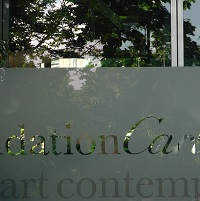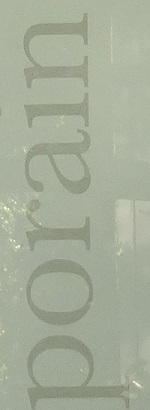
What role does the security detail play in the life of a museum? What is the interplay between the guards and the works of art they protect? Questions of the art of surveillance and the surveillance of art are delightfully and profoundly explored at the 30th anniversary exhibition at the Fondation Cartier pour l’art contemporain in Paris’s 14th arrondissement that runs through September 21, 2014.
So subtle is the interplay of surveillance and performance that it took this reviewer several minutes to grasp the true significance of the abundance of security personnel. As I visited the allocated space within the glass and steel building designed, I was increasingly enthralled by the way in which the foundation’s curators, financiers and merchants have create, inadvertently perhaps, a choreography of security personnel that offers deep insights into the work of the artists and the working of the foundation itself.
We spectators, arriving on Sunday afternoon with invitations and those invited to pay at the gate, were like shadows milling about, an unobtrusive audience leaving free range to the gestures, expressions and movement of the security personnel, themselves circumscribed by the work they “guarded.”
Dennis Oppenheim’s Table Piece, 1975, acquired by the foundation in 1996, occupies the larger of two rooms downstairs, where the presence of the vigils turns an examination of public discourse into a curatorial tour de force, however unintentional that may be. Oppenheim’s table organizes the space like the basement ping-pong table of American suburbia. Two doll-like figures, resembling Paul Simon circa 1969, sit on chairs at opposite ends of the long narrow table. One is gold and is dressed in a black suit, the other silver with a white suit. They call to each other “black, white, light, dark.” Evocative enough on its own, the installation is given greater presence thanks to the foundation’s decision to place a guard at each end, the one stout and vague in his gaze, the other a slight brune with glasses. But the overall effect would be narrow were it not for the presence of yet another guard in a corner of the room. Long jet black hair, an apprehensive stillness over a poised stance, she approaches after a moment the corpulent fellow and mouths something unheard as the Paul Simons quicken their dialogue of “black, white, light, dark.” (Performers will likely change through the length of the show.)
The French word for security guard is vigile. Linguistic “false friend” though it may be, I cannot help but think of the performers here as “vigils.” Their presence made for a tremendous performance piece in the eyes of this reviewer. Removed from the spectator yet one with him they stand near walls at the juncture of surveillance, witness, patience, participation.
Each work revealed itself in its dialogue with the vigils, and those interactions are so seamlessly spread throughout the space that one feels no dead zones of the they type that one might feel in, say, the Museum of Modern Art of the City of Paris. Indeed, it’s unlikely that a public museum could achieve the intensity of what is best called Dance of the Vigils.
A most extraordinary dialogue between the “vigil” and the artwork is found the smaller room in the basement. The room is dominated by Ron Mueck’s In Bed, 2005, created for the Ron Mueck exhibition of 2005. A stunning piece on its own, a giant figure lies as though in bed, knees raised, and watches visitors enter the room. Ill? Depressed? Psychotic? Dreamy? Expecant? Renounced?, the viewer wonders before noticing the guard standing awkwardly nearby, anxious witness to both the expression on the face of the figure and the wondering gaze of the viewer. But no? He is not witness; he is protagonist, a man caught between two worlds—the reality of the viewer and the unreality of the sculpture. He now skirts the room, entrapped, a man who cannot escape his larger-than-life wife or mother but aware that he must perform his “duty.” This is my favorite of the vigil scenes.
There are many others worthy of attention. A vigil at the bottom of the stairs, standing against a canary-yellow wall, is doomed, it seems, to watch visitors descend the final 6 steps after the landing. What, one wonders, is he watching, is he waiting for, is he expecting? He appears to be counting our rise and descent: 1, 2, 3, 4, 5, 6… 6, 5, 4, 3, 2, 1. I went up and down several times trying to grasp the nature of his performance. The rest rooms, I discover, are to his left down the hallway, one wall of which is bordered by transparent installations echoing the glass and steel of the building. The vigil against the canary yellow wall, counting our steps, therefore stands as ironic commentary on the transparency of numbers: years, dates, visitors, costs, etc. Fascinating.
 The foundation’s anniversary exhibition opened against a backdrop of rain clouds, sun showers, bright blue sky and May greens. It is dense with quiet staging of the apprehensive gaze of the personnel and the works on display. These “vigils,” each with a subtle mix of attentiveness, sexuality and distraction are dressed in black suits, black shoes, black ties and white shirts for the men, narrow black slacks and prudent blouses for the women. Some wear an ear piece, but for what?, the viewer wonders. In anticipation of Godot? of a bejeweled donor? of the entrance of an artist with “vision” or “plastic wit”?
The foundation’s anniversary exhibition opened against a backdrop of rain clouds, sun showers, bright blue sky and May greens. It is dense with quiet staging of the apprehensive gaze of the personnel and the works on display. These “vigils,” each with a subtle mix of attentiveness, sexuality and distraction are dressed in black suits, black shoes, black ties and white shirts for the men, narrow black slacks and prudent blouses for the women. Some wear an ear piece, but for what?, the viewer wonders. In anticipation of Godot? of a bejeweled donor? of the entrance of an artist with “vision” or “plastic wit”?
One male performer touches his earpiece as though to wonder if an organization so well-funded and clear-goaled a man might stand alone, apart, disconnected, perhaps abandoned. It’s a wonderful echo of Il Cavaliere di Dürer, 2011, by Allessandro Mendini, the work beside which he stands.
No sooner does that brief action take place than our—my— attention is drawn to that of two vigils standing together the playscape towers of Bodys Isek Kingelez’s Projet pour le Kinshasa du troisième millénaire, 1997. Approaching, I hear that they are discussing New York. Brilliant.
Inside, Raymond Hains’ Brise-lames de Saint Malo, plage du Sillon, 1994, and Jean-Michel Alberola’s Eclairage en groupe, 2014, serve as timid reminders that we are in France, otherwise the dearth of works by French-born artists draws attention to the lonely thumb in the garden by sculptor César, that seems to say that the new realism of the past 30 years is how little attention living French artists get (deserve?) on the international market. The panels describing the individual works are in French while the “vigils” are unnamed, undated. A brave curatorial approach, that.
I visit the garden, as is called the greenery that surrounds the glass box of the building. Through the transparent wall a vigil checks her phone. She is standing behind the brightly colorful partition “OMG!” by Allessandro Mendini and Peter Halley, 2014. How wonderful this illusion of hiding behind the bright wall while seen through the transparent wall, as though the latter were coverage by the mere fact of being an enclosure. Archictect Jean Nouvel should be pleased by this homage to his work.
 At the food shack by the garden café, its chairs empty but for the rain, a vigil, the only “client,” stirs his coffee, his red umbrella by his side. “Les photos,” he says, “sont interdites.” “Il est interdit,” he says, “de fumer dans le jardin.” His tone is light, apologetic yet clear, an magnificent articulation of the use of the word “interdire” (to forbid) in contemporary art foundations, where freedom of commerce encounters freedom of art under the complex gaze, at once placid and anxious, biding and operational, in need of coffee or a smoke or a message from the world beyond, of a dozen security figures. A celebration of artistic freedom circumscribed only by the forbidden and the unsaid.
At the food shack by the garden café, its chairs empty but for the rain, a vigil, the only “client,” stirs his coffee, his red umbrella by his side. “Les photos,” he says, “sont interdites.” “Il est interdit,” he says, “de fumer dans le jardin.” His tone is light, apologetic yet clear, an magnificent articulation of the use of the word “interdire” (to forbid) in contemporary art foundations, where freedom of commerce encounters freedom of art under the complex gaze, at once placid and anxious, biding and operational, in need of coffee or a smoke or a message from the world beyond, of a dozen security figures. A celebration of artistic freedom circumscribed only by the forbidden and the unsaid.
I return inside, drawn still to this extraordinary performance of the security personnel. At times the “vigils” don’t seem to watch as much as they do to submit to the space, the sound, the color, the movement. I look up to the bookshop balcony. There, arms crossed, stands a vigil with shave head—an excellent choice of figures since we think of him as the most guard-like. He stands as straight-faced commentary on the hinge of the conversation between commerce and art; the vigil against the canary yellow wall stands between foundation and basement; the vigil furtively checking her phone stands between the opaque and the transparent; the vigil by In Bed acts out the works emotions in a confrontation between display and (in)security; a vigil stretches discreetly from the back of the screening space, loosening wrists, stretching shoulders.
Is this planned or unintentional or inevitable? No matter. I cannot imagine a better way to celebrate the foundation than with this Dance of the Vigils.
1984-2014: 30 Years at the Fondation Cartier pour l’art contemporain, May 10-Sept. 21, 2014. 261 boulevard Raspail, 14th arrondissment. Metro Raspail or Denfert-Rochereau or RER Denfert-Rochereau. Open daily except Monday 11am-8pm and until 10pm on Tuesday. 10€; 7:€ for students and those under 25; free for children under 13 or on Wednesday for those under 18. For further information see www.fondationcartier.com.
© 2014, Gary Lee Kraut


